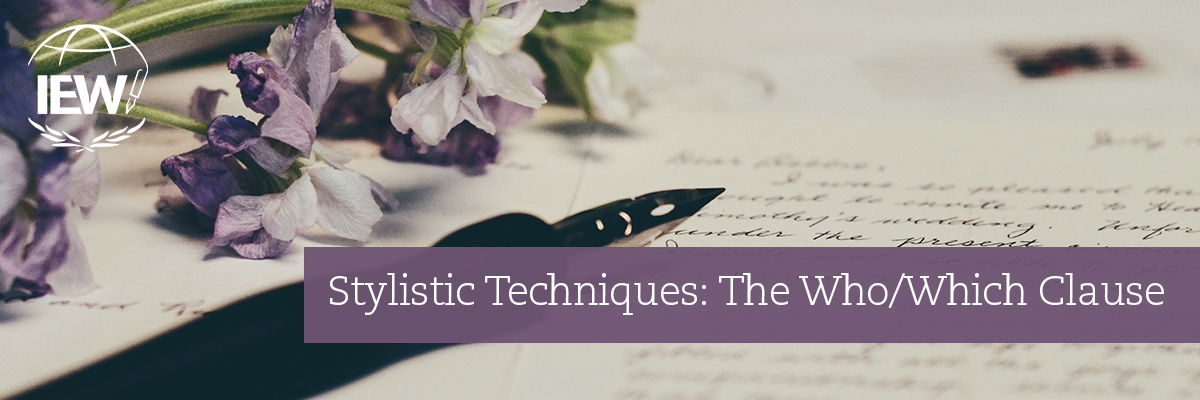
After students learn how to insert a -ly adverb, the next stylistic technique they learn to construct is a who/which clause, a type of adjective clause. In grammar, a clause has two parts: a subject and a predicate (verb). In who/which clauses, the who or which serves as the subject of the clause, which is performing the action of the verb. They are dependent clauses, meaning they cannot stand alone as a complete sentence.
There are two types of who/which clauses: essential and nonessential. Nonessential clauses add extra context and meaning to the main clause of the sentence just as do essential clauses, but they differ from essential clauses in that they can be removed without affecting the meaning of the main clause. Nonessential who/which clauses require a comma or commas depending upon their placement in the sentence.
Playing around with who/which clauses helps us to deepen our understanding of this grammatical construction. When I am working with my students, I like to create who/which practice sentences from experiences personal to my students’ lives. It motivates my learners when the content is all about them! Let’s imagine I have a student named Sally. I know that this student has a cat named Tippy. I also know (because I’ve seen her cat) that this particular kitty is gray, quite fat, and missing the tip of his left ear. To help my student practice inserting a who/which clause, I might begin by first creating two independent clauses using the facts I have.
Here are two sentences to get us started:
Tippy is a gray cat.
Tippy is very fat.
We would begin gently by using these simple sentences, practicing to combine them with either a who or a which. Younger students usually find it easiest to insert a who or which right after the noun it describes. Because our pets are like family, in this case we would be using who:
Tippy, who is a gray cat, is very fat.

Perhaps your student is quite a soccer player. Use that to launch the learning:
Sally currently plays keeper on her soccer team.
She wants to become a striker.
Providing those two sentences, your student can create a single sentence that uses a who clause:
Sally, who currently plays keeper on her soccer team, wants to become a striker.
Once your student feels more comfortable with creating who/which clauses from two separate sentences, you can turn your attention to the key word outline. Look for a fact in the outline where you can add additional information. Sometimes you can find an opportunity to create a who/which clause from one line of notes; other times you may find a great combination by pulling it together using two lines of notes from the outline.
As I mentioned above, who/which clauses can be either essential or nonessential. Why does this matter? Primarily the reason it’s important to know which type of clause you have is because it will dictate whether or not the clause requires commas. Nonessential who/which clauses take commas, but essential who/which clauses do not. How do you know which type of clause your student’s is? Ask this question: If I remove the clause from the sentence, does it change the meaning of the rest of the sentence or specify who or what? If the answer is “yes,” it is an essential clause, which does not take commas. Here is another example using sweet Tippy:
The cat who ate every other cat’s leftover food as well as all of his own is named Tippy.
It is a very specific cat who ate all of that food: the rotund yet lovable and sweet-tempered Tippy. If I were to remove the who clause, the sentence would not maintain its meaning:
The cat is named Tippy.
In order for the sentence to make sense, we need to know which cat gobbled up all the food. Removing the who/which clause strips away the primary reason for the sentence: to point out which pussycat is the hungry food thief.
By contrast, nonessential who/which clauses should be set off by a comma or commas. If the clause interrupts the middle of the sentence, place commas before the who and after the clause ends, as demonstrated in the first examples. Who/which clauses that come at the end of the sentence only require a comma and then the end punctuation. Here’s an example:
Tippy ate not only all of his food but all of the other cats’ leftover food as well, which might explain why he is so corpulent.
Don’t forget that all dress-ups should be underlined; the rule is to insert one of each type into each paragraph. If you are following the EZ+1 approach, this should never become burdensome to your students.
If you are looking for more opportunities to practice inserting who/which clauses, I highly recommend you check out Fix It! Grammar. Beginning in Book 1 of the program, The Nose Tree, students get practice identifying and marking who/which clauses. In Book 2, Robin Hood, they begin to edit the passages to combine two sentences using a who/which clause. Students enjoy wearing the “editor’s hat” as they work through the passages, and it’s also a great way to help them learn grammar from a point of relevance.
I hope this post has helped you think about ways that you can introduce and strengthen your students’ understanding of the who/which clause. While their initial efforts may be a bit awkward, with continued practice and your encouragement, your students will gradually begin to become more confident and elegant when they add in this stylistic technique. Practice makes progress!
|
Jennifer Mauser has always loved reading and writing and received a B.A. in English from the University of Kansas in 1991. Once she and her husband had children, they decided to homeschool, and she put all her training to use in the home. In addition to homeschooling her children, Jennifer teaches IEW classes out of her home, coaches budding writers via email, and tutors students who struggle with dyslexia. |

